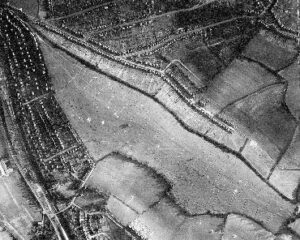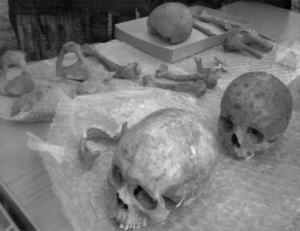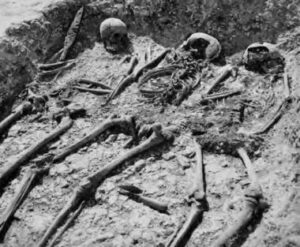Within the ECRA area and a short walk from Coulsdon South Station are the very popular Farthing Downs and Happy Valley, with Saxon burial mounds and Iron Age field system. The City of London Corporation manage the Downs and publish the latest information on car parking, site information and contact details for rangers. The area has been awarded Green Flag status, an independently judged award given annually to the best parks and green spaces in England and Wales.
If you want to get involved in promoting and protecting Farthing Downs & Happy Valley, you can join the Friends of Farthing Downs. The Friends are a local group run by volunteers who work in partnership with the City of London and Croydon Council to shape projects, organise talks and guided walks.
For a booklet on ten walks in and around Happy Valley please e-mail
If you would like to get involved in hands-on outdoor work why not think about helping the Rangers on Farthing Downs, the work is rewarding and you can help to conserve and protect an important wildlife and archaeological site. Contact the City of London’s Ashtead Office on 01372 279083 or e-mail
Walking for Health run regular health walks on Farthing Downs and Kenley Common throughout the year. For latest times and information, visit the to the Walking for Health website.
About the Downs

Farthing Downs and Happy Valley were acquired through the Epping Forest Act and the Open Spaces Act, adopted in 1878 as a result of concern about building development. The legislation enabled the Corporation of London to acquire open spaces within 25 miles of the City for the ‘recreation and enjoyment’ of the public’.
The Downs cover 120 acres which is largely grassland. In summer it is a riot of colour. There is a well sign-posted circular walk. The City Of London Rangers’ conservation work includes the management of cattle and sheep to ‘mow’ the grasslands re-introduced to The Downs a few years ago. They have put up new benches whose tops are made from felled trees; maintain the fencing and often give talks and lead walks.
A fund raising campaign by the Coulsdon Green Belt Action Group helped the acquisition of Woodplace Farm Fields, now managed by the City as a local open space. In 2006 the Friends won funding to support an archaeological survey on the Downs carried out by volunteers organised by English Heritage.
A Celtic field system was discovered in 1939 during the building of anti-aircraft trenches. In 1948 and 1949 a Saxon cemetery was discovered dating from the late 6th and 7th centuries. Some 20 burial barrows were found, along with many other flat graves.
You can also look out for the Millennium Cairn which contains a time capsule and has a metal plate giving pointers to various places of interest. The cairn was unveiled in October 2000. From here there are magnificent views all around.
The Corporation re-introduced cattle to The Downs in 1994 as the most efficient way to maintain the land as traditional chalk grassland.
The road over the Downs was the original Brighton Road before the Prince Regent instigated the building of the new Brighton Road – now known as the A23 – so that he could get to Brighton and his Pavilion as quickly as possible.
If you follow the road towards Chaldon you will pass a house which was originally a Coaching Inn. Sadly the swing boats which were once here have long since been removed. Further on this road you will come across the ancient pre-Norman Chaldon Church which was recorded in the Doomsday Book.
Happy Valley was turned into an open space in 1937 and 1938, when various local farms were bought by Coulsdon Council as part of the London Greenbelt scheme, which sought to limit the spread of London by preserving a ring of open countryside around the city. It is a Site of Special Scientific Interest for its flora and as a habitat for ground nesting birds such as larks.
Saxon Graves on Farthing Downs

Farthing Downs from the Air
There are many signs of ancient habitations to be found in Coulsdon and on Farthing Downs in in particular. Farthing Downs has been known as a site of geological and archaeological interest since the 18th century and Archaeological digs and studies have taken place by John Wickham Flower in 1871, Dr Brian Hope-Taylor excavation of flat graves, ancient trackway and Celtic field boundaries 1947/1948 and more recently by Barry Taylor of London University and Amy Grey Jones of the Museum of London April 2005 – March 2006.
Farthing Downs is a steep sided chalk ridge which runs north/south as a projecting spur of the North Downs. Running along the ridge are ancient earthworks consisting of a field system (east/west) organised around a linear drove way (north/south). These features are believed to date from the late Iron Age (200 BC) and are assumed to be fields associated with nearby settlements on Wooodplace Farm in Woodplace Lane (now demolished). Along with a Celtic presence between BC50 and 150AD.

Saxon Grave uncovered on Farthing Downs in 2006.
The next people to use Farthing Downs were the Romans. Hope-Taylor, suggest that the Downs were both farmed and supported a small settlement. The Downs continued to be occupied following the Roman occupation from 43 to 410AD Fragments of Roman pottery (Samian ware) which were imported from Gaul, were also found during the excavations in 2005 adding to the Roman artefacts found by Hope-Taylor in the 1940s. We know that the Romans imported the Edible Roman Snail to the Downs and they can still be found on the Downs today.
This followed occupation by the Saxons in the 7th century. A number of Saxon burials have been found by all three Archaeological digs. These include two Saxon barrow cemeteries. There are also isolated barrows to the south and a small flat grave cemetery dating from the same time between the 6th and 7th century. Cuthræd The Saxon warrior that Coulsdon is named after was buried here.
The Saxon Graves are north to South and are usually buried with a weapon swords or spears. While the Roman Graves are generally East to West in the Christian tradition.

Saxon Grave uncovered on Farthing Downs in 2006.
Saxon Grave uncovered on Farthing Downs in 2006.
Farthing Downs gained Ancient Scheduled Monument Status in 1948 and in 1970 was made a Site of Special Scientific Interest (SSSI).
More information can be found on the Friends of Farthing Downs and Happy Valley website.
